Розпорядок дня. Годинник
Англійська мова. 4 клас (за підручником О. Карп’юк) - плани-конспекти уроків англійської мови
Lesson: Розпорядок дня. Годинник
Мета:
• навчальна: презентувати новий граматичний і лексичний матеріали за підтемою «Розпорядок дня», практикувати мовні засоби за підтемою «Розпорядок дня», формування навичок вживання нових лексичних одиниць, вдосконалювати компетенції читання, аудіювання й усного монологічного мовлення;
• розвиваюча: уважно стежити за презентованою інформацією, ефективно співпрацювати під час парної та групової роботи, мотивувати готовність брати участь в іншомовному спілкуванні, розвивати різні типи пам'яті — слухову, зорову, увагу, уяву, учити працювати у парі, логічно висловлювати думку;
• виховна: виховувати уміння сконцентруватися, слухати інших, формувати доброзичливу атмосферу в класі.
Обладнання: картки за підтемою «Розпорядок дня», плакат "Present Simple".
Хід уроку
-
Вступна частина.
- Привітання: Good morning, children!
-
Good morning, teacher!
- Фонетична зарядка.
- Let’s read the poem What to put on?
I have a yellow blouse My dress is purple,
I have a red skirt My suit is blue.
I have brown trousers So, we are ready,
I have a white shirt And what about you?
- Мовленнєва зарядка:
- How are you? (I am fine/good/bad)
- What is the weather like today?
- What day is it today?
- What is your favorite day/ lesson?
- What was the hometask for today?
-
Основна частина уроку.
- Перевірка домашнього завдання.
- Подача нового матеріал
Today, we will be speak about the time of day.
“Remember”
Revise the words “o’clock”, “past” and “to” with the time. If pupils don’t understand the meaning of the words, translate them into the native language pointing to a demonstrative clock.
Read out the sentences. You can use a demonstrative clock again.
Pupils listen, look at the time on the clock and read sentences in silence.
- Робота з таблицею, пояснення матеріалу
What is the time?
It is a quarter to two. It is a quarter past five. It is half past nine. 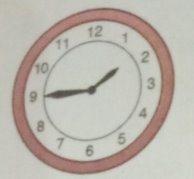
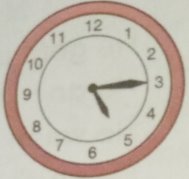
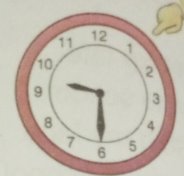
a.m.-використовується «до полудня»;
p.m.-«після полудня».
Remind pupils to use “at” with a time of a day.
Pupils read and practise the pronunciation.
Do choral and individual reading.
- Тренування в мовленні.
What is your favorite part of the day?
When do you watch cartoons/listen to music?
When do you usually do your homework (morning/afternoon/evening)?
When do you have dinner/play games?
When do you go to bed?
- Pобота з підручником
Match the clocks to the sentences (p. 30, ex. 1).
Ask pupils to look at the time on the electronic clocks.
Then ask pupils to read the sentences which say the time.
Ask pupils to choose the right sentence and match it with the correct clock.
Pupils may also be asked to write sentences with the correct letter in their exercise books and on the board.
![]()
![]()
![]()
![]()
![]()
![]()
![]()
![]()
![]()
![]()
![]()
![]()
![]() It is half past ten.
It is half past ten.
![]()
![]() It is a quarter past two.
It is a quarter past two.
It is a quarter past four.
![]()
![]() It is a quarter to five.
It is a quarter to five.
It is half past twelve.
![]() It is a quarter to three.
It is a quarter to three.
Answers: 1. d; 2. c; 3. e; 4. a; 5. f; 6. b.
Listen and read. Draw the clocks in your copybook (p. 30, ex. 2).
Ask pupils to look at the pictures in the exercise. Also point out what Vicky does in the morning, in the afternoon and in the evening.
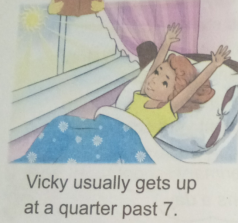
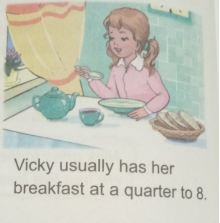
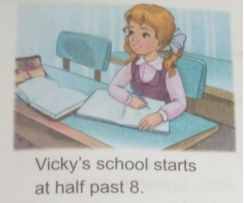
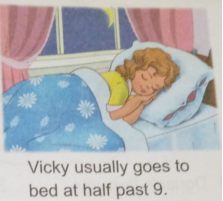
Read the sentences pointing to the pictures. Mime the actions if it is necessary. Also point to the table “Present Simple” and pay attention to verbs “gets up”, “has breakfast” and etc. Explain the rule in the native language if it is necessary.
Then ask pupils to draw the clocks in their copybooks.
Then ask pupils to draw the time.
Pair work: Pupils in pairs take turns to ask and answer questions about Vicky’s morning, afternoon and evening following the model questions and answer them. Write down the model questions on the board.
|
When does Vicky |
wake up? |
|
|
go to school? |
|
|
have breakfast? |
|
What time does Vicky |
wake up? |
|
|
start school? |
|
|
have breakfast? |
|
|
start lessons? |
|
|
go to bed? |
Copy and answer the questions (p. 31, ex. 3).
Pupils open their copybooks and copy the sentences finishing them.
Tell pupils they can use the information from the text. Ask some pupils to write the sentences down on the board while the rest of the pupils are writing in their copybooks.
- What does Vicky do at a quarter to 8?
- What time does Vicky go to bed?
- When does Vicky's school start?
- What does Vicky do at a quarter past 7?
Answers:
1. She usually has her breakfast at a quarter to 8.
2. She usually goes to bed at half past 9.
3. Her school starts at half past 8.
4. She usually gets up at a quarter past 7 .
Tell class about your friend (p. 31, ex. 4).
Tell pupils they are going to describe their friends using the patterns in the speech bubble.
Pupils look at the patterns in speech bubble about Bob.
Ask pupils to finish the sentences using the correct time.
Ask pupils to make sentences about their own friends using the sentences about Bob.
Ask to begin with the words “I have got a friend. His/Her name is ...”
My friend.
I have got a friend.
His/Her name is ….
He/She usually wakes up at…….
He/She usually has her breakfast at ……..
He/She usually goes to school at ……..
His/Her school starts at …….
He/She usually does his/her homework at……
He/She usually goes to bed at ……….
-
Заключна частина.
- Подача домашнього завдання: Ex. 5 P. 31, WB p.
- Оцінювання.


про публікацію авторської розробки
Додати розробку
